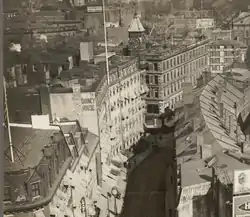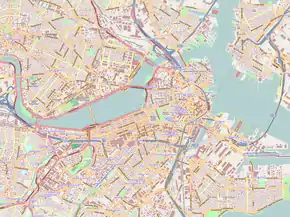| Quincy House | |
|---|---|
 Quincy House (left), c. 1920. The clock tower marks the southeastern corner of the hotel. | |
 Location within Boston | |
| General information | |
| Type | Hotel |
| Location | Brattle Square Boston, Massachusetts United States |
| Coordinates | 42°21′36″N 71°03′31″W / 42.3600°N 71.0587°W |
| Opening | c. 1819 |
| Renovated | c. 1885 |
| Demolished | 1935 |
| Technical details | |
| Floor count | 7 |
| Floor area | 23,500 sq ft (2,180 m2) (approx.) |
| Other information | |
| Seating capacity | 500 (approx.) |
| References | |
| [1][2] | |
The Quincy House was a hotel in downtown Boston, Massachusetts, United States. Located on the corner of Brattle Street and Brattle Square in the neighborhood of Scollay Square, it was in operation for most of the 19th and early 20th centuries, before it was closed in 1929. It was the largest hotel in Boston in the late 19th century,[3] and was a popular destination for prominent guests to the city.[4] It also served as a major headquarters for labor unions in Boston.
History
The original Quincy House was built in the early 1800s, on the site of the first Quaker meeting house in Boston.[1][3] The hotel was built with Quincy granite, making it the first building in Boston to be constructed with that material.[5] Over the course of the 19th century the hotel received several renovations and additions, the most extensive expansion occurring in c. 1885.[1] By the end of the 19th century, the building reached seven stories in height[6] and had approximately 500 rooms.[1]
By the late 1800s, the Quincy House acquired a reputation as one of the most famous hotels in the city. Labor unions in particular frequented the establishment; labor leaders and strike committees customarily held their meetings there.[7] The regular union presence at the Quincy House eventually resulted in the hotel advertising itself as the "official headquarters for organized labor" in the city.[8] The Quincy House additionally served as a popular place for local politicians, and it especially became known as the meeting place of the Board of Strategy, a group of high-ranking Democratic politicians (including P. J. Kennedy) who selected candidates for office and distributed patronage to party loyalists.[3][9][10]
The Quincy House's popularity began to suffer in the early 20th century; labor patronage declined during this period,[7] and the building was eclipsed by newer hotels in the city.[11] It was ultimately unable to recover from this downturn and closed on September 15, 1929.[12] The hotel remained vacant for several years, during which the Suffolk Savings Bank and the First National Bank of Boston each acquired separate parcels of the building.[2] In late 1934, the banks decided to raze the hotel, and in early 1935 it was demolished and replaced with a parking lot.[3][7][11][13] The site is now occupied by City Hall Plaza, in front of Boston City Hall.[14]
Images
 The old Quincy House, 1800s
The old Quincy House, 1800s The old Quincy House (center, in front of the Brattle Street Church), c. 1860
The old Quincy House (center, in front of the Brattle Street Church), c. 1860 The Quincy House after its expansion, c. 1885
The Quincy House after its expansion, c. 1885 Map of Boston, showing location of the Quincy House (lower left), 1896
Map of Boston, showing location of the Quincy House (lower left), 1896 Quincy House (far left), c. 1905
Quincy House (far left), c. 1905
References
- 1 2 3 4 Ellis, George E. Bacon's Dictionary of Boston. Boston: Houghton, Mifflin & Co., 1886. pp. 341-42.
- 1 2 "Banks Soon to Decide on Quincy House Disposition." Boston Daily Globe. 27 December 1934: p. 7.
- 1 2 3 4 "Mayor Couldn't Get Into Quincy House." Boston Daily Globe. 19 September 1956: p. 36.
- ↑ "Quincy House Front is Sold." Boston Daily Globe. 10 October 1924: p. 28A.
- ↑ Kruh, David. Always Something Doing: Boston's Infamous Scollay Square. Rev. ed. Boston: Northeastern University Press, 1999. ISBN 1-55553-410-4. p. 24.
- ↑ "Necrology." New England Magazine and Bay State Monthly Nov. 1886: 287-91. p. 290
- 1 2 3 "Third Quincy House Blaze in 48 Hours." Boston Daily Globe. 22 January 1935: p. 3.
- ↑ The Quincy House. Advertisement. American Federationist Aug. 1918: 848.
- ↑ Nasaw, David. The Patriarch: The Remarkable Life and Turbulent Times of Joseph P. Kennedy. New York: The Penguin Press, 2012. ISBN 978-1-101-59591-6
- ↑ Davis, John H. The Kennedys: Dynasty and Disaster. New York: Shapolsky Publishers, 1992. ISBN 1-56171-060-1. p. 34
- 1 2 "Almost a Memory." Boston Daily Globe. 27 December 1934: p. 14.
- ↑ "Door is Locked at Quincy House." Boston Daily Globe. 16 September 1929: p. 1.
- ↑ "Boston Proper and Back Bay." Map. Atlas for the City of Boston. G. W. Bromley & Co., 1938. Web. 13 May 2013. (shows the Quincy House has been replaced by a parking lot)
- ↑ Sammarco, Anthony Michael. Boston: A Century of Progress. Charleston, SC: Arcadia Publishing, 1995. ISBN 0-7385-3876-0. p. 28.